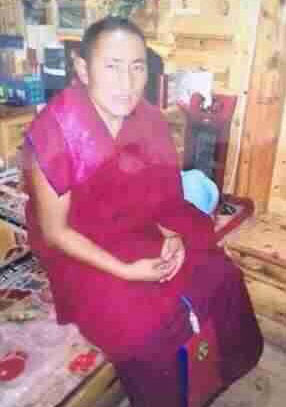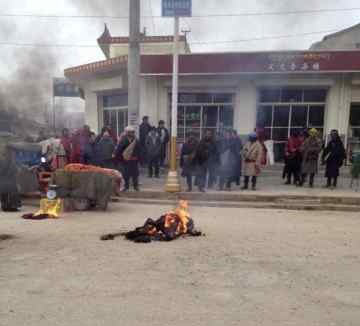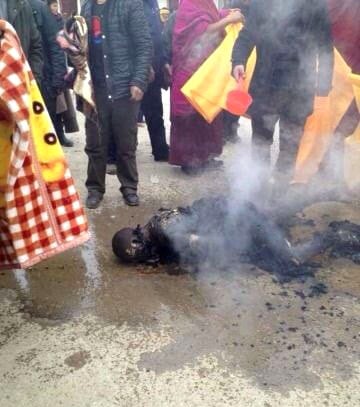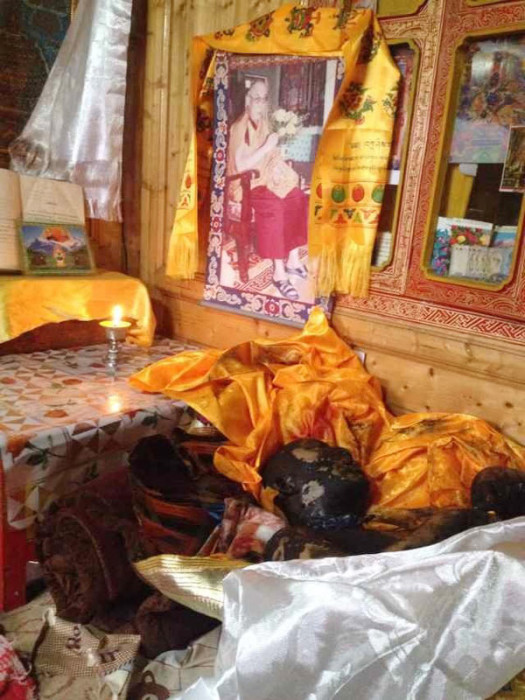[box type=”note”]WARNING: Graphic image [/box]

Portrait of monk Tsultrim Gyatso, who set himself on fire and died on December 19, 2013.
Monks gathered to pray after a respected Tibetan monk called Tsultrim Gyatso set fire to himself and died yesterday (December 19) in Amchok township in Sangchu (Chinese: Xiahe), Gansu. It was the 125th self-immolation in Tibet since February, 2009.
Graphic photographs (see below) emerged from Tibet of the self-immolation of Tsultrim Gyatso, who was in his early forties. According to Tibetan exile sources, monks gathered at Amchok to pray for him, and later in the evening were seeking to take his remains for a sky burial at Labrang monastery in Gansu.
Tsultrim Gyatso is the 11th Tibetan from the Sangchu area in Kanlho (Chinese: Gannan) Tibetan Autonomous Prefecture to set fire to himself since the wave of self-immolations began in Tibet in 2009 (ICT, Self-immolations by Tibetans).
Tsultrim Gyatso was highly educated, and respected for his knowledge of Tibetan history and literature.
A handwritten note with Tsultrim Gyatso as the signatory was received by Tibetans in exile. The note, which refers to the self-immolation as a sacrifice towards ensuring the return of the Dalai Lama to Tibet, is a strong statement of endurance and despair written in religious language and asserting the core values of Tibetan Buddhism and the importance of its survival. According to one source cited by Radio Free Asia: “Before his self-immolation at a cross-section in Sangchu, he went to his room after lunch break, lit a lamp, opened a book on the teachings of Buddha and wrote his one-page suicide note,” a Tibetan lecturer at the Dalai Lama Institute for Higher Education (DLIHE) in Bangalore, India, told RFA’s Tibetan Service. (December 19, 2013).
The note, written in a form like a poem, with a title, ‘Golden Tear Drop’, opens with an expression of anguish that the sufferings of Tibetans are not being heard and addressed (‘To whom should the sufferings of the six million Tibetans be conveyed?’) It refers to oppression in Tibet and the exploitation of its natural and mineral resources. The note states that the self-immolation is an “offering” for the return of the Dalai Lama to his homeland, the release of the young Panchen Lama (held in custody by the Chinese authorities since 1995) and for the welfare of the Tibetan people, with the note stating: “My body has been offered to the fire for these.”
The note is translated into English by ICT below:
“Golden teardrop
Oh! A tear drop
Beloved, Brother [a respectful term that appears to be addressing a general audience]. Did you hear? Did you see? Did you listen? To whom should the sufferings of the six million Tibetans be conveyed?
The Chinese state is ruthless; the treasure-trove of gold and silver is being looted; the subjects are being oppressed. Thinking of this, tear drops fall.
The immolation of one’s precious body was for the return of Gyalwang Tenzin Gyatso [the Dalai Lama] to his homeland; for the release of the Panchen Nangwa Thaye [The Panchen Lama] from prison; for the welfare of the six million Tibetans. My body has been offered to the fire for these.
By the grace of these, the prayer is for all the sentient beings of the three realms[1] to escape from the three poisons[2] and proceed on the path of enlightenment.
(My) Lama and the three gems,[3] it is up to you; please view with compassion those who have no protectors and saviors.[4]
Brethren of the snow mountains, unite for Tibet […] [rest of sentence illegible].”
As in the case of Tsultrim Gyatso, Tibetans who have left testimonies or notes behind to be found after their self-immolation have in general not called for other Tibetans to carry out these acts. Mostly their communication has been addressed to fellow Tibetans, as opposed to the Chinese authorities or the international community, and calls for life-affirming actions of protecting Tibetan cultural identity and connecting to each other as a way of determining their own destiny.
The young Kirti monk Phuntsog, who self-immolated on March 16, 2011, told fellow monks while he was dying: “My last message for the six million Tibetans is to unite, like malas [prayer beads] on a string, linking every Tibetan. Tibetan people should work together for the cause as much as they can.” (The ICT report, ‘Storm in the Grasslands’ includes an analysis of notes and statements left behind by those who have self-immolated).
[box type=”note”]WARNING: Graphic image [/box]

Tsultrim Gyatso ablaze and after his self-immolation.

Tsultrim Gyatso ablaze and after his self-immolation.

Tsultrim Gyatso’s body after his self-immolation.
Footnotes:
[1] According to Buddhist cosmology, there are three realms — or types — of existence: the Realm of Desire, the Realm of Form, and the Realm of No-Form.
[2] The three Buddhist poisons are ignorance, attachment, and aversion
[3] The three gems, or three jewels, are The Three Jewels are: the Buddha (either the historical Buddha, or the Buddha nature, the highest spiritual potential that exists within all beings); the Dharma (the teachings of the Buddha); and the Sangha (the community of practicing Buddhists, or the community of Buddhist monks and nuns.
[4] This is most likely to be a reference to the absence of the Dalai Lama in Tibet and the conditions of religious oppression. A Dharma Protector is an emanation of a Buddha or a Bodhisattva whose main functions are to avert the inner and outer obstacles that prevent practitioners from gaining spiritual realizations, and to arrange all the necessary conditions for their practice.

